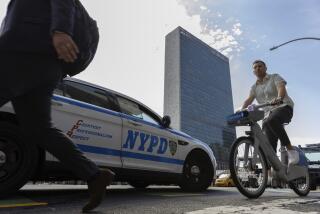Diplomacy : Gap Visible in Summit Plans for Have, Have-Not Nations
- Share via
UNITED NATIONS — On paper, the idea shines with a brilliance that ought to attract President Clinton: Assemble all the leaders of the world in a U.N. conference dealing with the torment of the hundreds of millions of people falling by the wayside in an era of change.
But diplomats preparing for the World Social Summit--or, as it is sometimes called, the People’s Summit--in Copenhagen in March are worried.
There are signs that the planned session could turn into a North-South war of words--continual rounds of acrimony between industrialized and developing countries. And if it does, U.S. officials hint, Clinton will probably not go.
But diplomats, who completed a preparatory meeting at U.N. headquarters in New York last month, will meet there again in January in hopes of working out an agenda to ensure a meaningful summit. U.S. officials were somewhat disappointed with the August meeting.
“Very few people came here with a firm agenda for the social summit,” a State Department official said. “And a lot of rhetoric was puzzling.”
The idea for the summit was advanced first by Patricio Aylwin, former president of Chile.
He noted a growing agreement on the political and economic roads that governments must take in the post-Cold War era: Democracy is the only real political choice, and free markets are the only real economic choice.
But he argued that no consensus is forming on the social choices that must be made in the post-Cold War era. Many people are confused and hesitant about what they ought to do about poverty, jobs, stagnant development, expanding gaps between the richest and the poorest, ethnic strife and foreign aid.
A summit might come up with social solutions or, at least, the germ of them. But the subject is so vast and unwieldy that it lends itself to interminable, numbing talk and to idealistic proposals that have little chance of realization.
U.S. diplomats, who support the idea of a social summit strongly, want the issues more focused and down-to-earth.
Under the chairmanship of Chile’s ambassador to the United Nations, Juan Somavia, the preparatory committee did a good deal of rewriting in August its proposed “draft program of action” for the summit--but, in the view of the Clinton Administration, not enough so far.
One issue centers simply on numbers and formulas. The draft program, for example, calls on industrialized nations to fulfill a U.N. goal of devoting 0.7% of their gross national product to foreign aid for developing countries.
“That would mean increasing our development assistance from $8 billion a year to $45 billion a year,” the State Department official said.
*
U.S. officials believe that the summit should focus on what can be done to develop poor nations without calling for spending boosts that few donor governments will accept.
The Americans would prefer, instead, that the summit agree to change development programs so they concentrate on projects such as potable water, sanitation and universal education that help alleviate poverty.
The Americans also fear that developing countries might try to turn the summit into an exercise in bashing the World Bank and the International Monetary Fund.
U.S. officials agree that the bank’s “structural adjustment” programs have gone awry. Under these programs, Third World governments must tighten their budgets, reduce government employment, eliminate food subsidies and devalue their currency before receiving World Bank and IMF loans.
The strictures are designed to improve the economies in the long run, but, in the short term, they increase unemployment and the cost of goods, causing hardship.
U.S. officials fear that Third World governments want to put the World Bank and IMF under the control of the United Nations, where these governments have an overwhelming majority.
More to Read
Get the L.A. Times Politics newsletter
Deeply reported insights into legislation, politics and policy from Sacramento, Washington and beyond. In your inbox twice per week.
You may occasionally receive promotional content from the Los Angeles Times.










